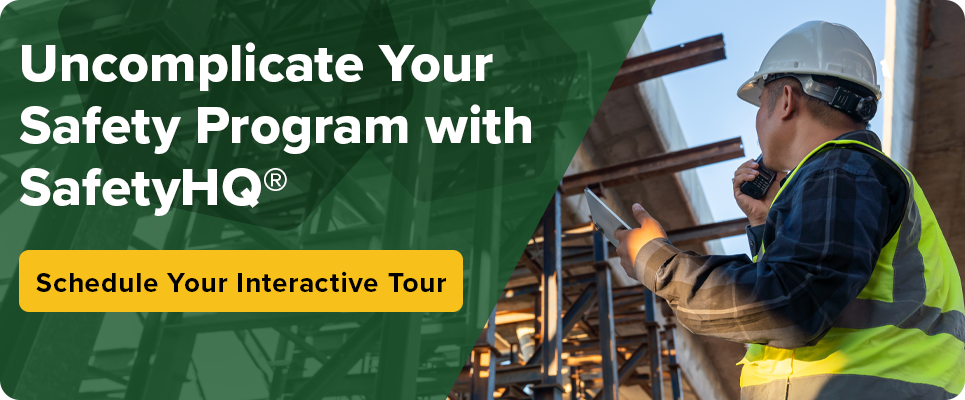
OSHA statistics show an average of around five thousand U.S.-based work fatalities per year. To put that in perspective, that’s about 100 deaths per week, or 15 a day.
That means, approximately every hour and a half, some company out there has to call their employee’s family and explain that their loved one won’t be coming home from work that day. That is a call you never want to have to make, and you definitely don’t want to receive.
OSHA also reports that the number one cause of these construction fatalities, year after year after year, is falls. The good news is that you and your employees don’t have to be a part of those statistics.
(Learn about what your employees need to know from a Vehicle Safety Toolbox Talk Topics)

How to Avoid Falls at Your Construction Company
First, you need to be aware that there are two categories that falls fall into. See what I did there?
1. Falls on the Same Level
These are most commonly referred to as slips and trips, which result in a fall to the ground. It could also be as simple as an employee stepping awkwardly out of their truck and falling to the ground.
Falls in this category, while potentially disabling, are not considered serious as they are not usually life-threatening.
2. Falls to a Lower Level
This category involves the more serious and, more often, fatal falls. It includes falling at any height to the ground or a level below where the employee originated from. This could be from a roof, scaffolding, down a stairwell, off a ladder, and more.
The suggestions in the remainder of this article focus on protecting your employees from this category of falls as they are the types more likely to result in death. If your current concern is about slips and trips, your focus should be on general site housekeeping.
Specific Topics to Focus Your Fall Safety Training On
We all know that holding regular safety meetings, called Toolbox Talks, is the basis of a good safety program.
The problem for many contractors arises when you find yourself at a loss for relatable, useful topics to cover.
Below, we have sourced out some fall prevention subcategories and the topics you should focus on within them.
1. Ladder Safety
When it comes to falls, falling off a ladder tops the list as the most common. Your three areas of focus should be:
- Proper setup of an extension ladder
- 3 Point Contact
- Stepladders
2. Scaffolding
Anyone assigned to set up scaffolding should have proper formal training in doing so as one mistake on their part could cost their co-workers their life. However, anyone using scaffolding should have at least a basic understanding of the following:
- Set up of structural components
- Set up of planks and decks
- Fabricated Frame Scaffolds
3. Suspended Access Equipment
This subcategory includes all equipment that provides an elevated work platform, such as aerial lifts. Anyone using such equipment should have proper formal training, but a toolbox talk refresher is always a good idea:
- Calculating counterweight
- Tiebacks
- Personal Fall Protection
4. Fall Protection
Some trades are at a higher risk of fall fatalities simply based on the tasks they perform and the frequency at which they are exposed to fall hazards. These trades need to put additional emphasis on fall protection through formal training. However, Toolbox Talk refreshers are also a must. Here are the topics you should be covering:
- Basic types
- Guardrails
- Personal Fall Arrest Systems
- Rope Grabs
- Warning Line Systems
- Safety Monitoring Systems
- Approvals and Inspections
5. Other Causes of Falls
It is incredibly rare for any construction worker in any trade not to be exposed to a fall from heights at some point throughout their day. We strongly recommend training everyone in at least the basics:
- Skylights and Roof Openings
- Floor Openings (Stairwells)
- High Winds
- Falls from truck beds
6. Rescue Procedure
In the event that there is a fall on the job site, workers need proper training on what to do. There should always be at least one designated person with First Aid / CPR training onsite, but everyone else should also understand their own responsibilities in an emergency. Here are the areas you should cover:
- Emergency Action Plans
- Assisted Rescue
- Self Rescue
Access to all these toolbox talks and more in their account library is one of the many benefits of being a SafetyHQ client. If you are not yet a client, you can check with your local trade association to see if they have content on the above topics available to you.
Conducting Safety Training Works
In the 70’s, the average number of deaths per day was 38. Since then, the efforts of OSHA, health and safety professionals, unions, and other advocates have brought awareness to construction safety and provided ways to prevent accidents through training.
This has resulted in a significant drop to 15 deaths a day and proves that training works. The most important contributors to this improvement are the employers who make safety a priority on a daily basis.
Even still, 15 deaths a day that could have been prevented is 15 too many. In order to get this number down, every single employer must be committed to the health and safety of their workers.

Make the Commitment to Safety
The mere fact that you are reading this article, proves that you are on track to make a difference at your own company. The most successful safety programs are run by companies that create a positive culture of worker safety.
To find out how they do that, you need to read:
Top 5 Ways to Foster a Safety Culture in Your Construction Business
Share Article
Keep on current news in the construction industry. Subscribe to free eNews!



